
86% of participants performed better with Signia Integrated Xperience versus key competitor in noisy group conversation
Audiology Online, April 2, 2025
Read more
Audiology Online, April 2, 2025
Read more
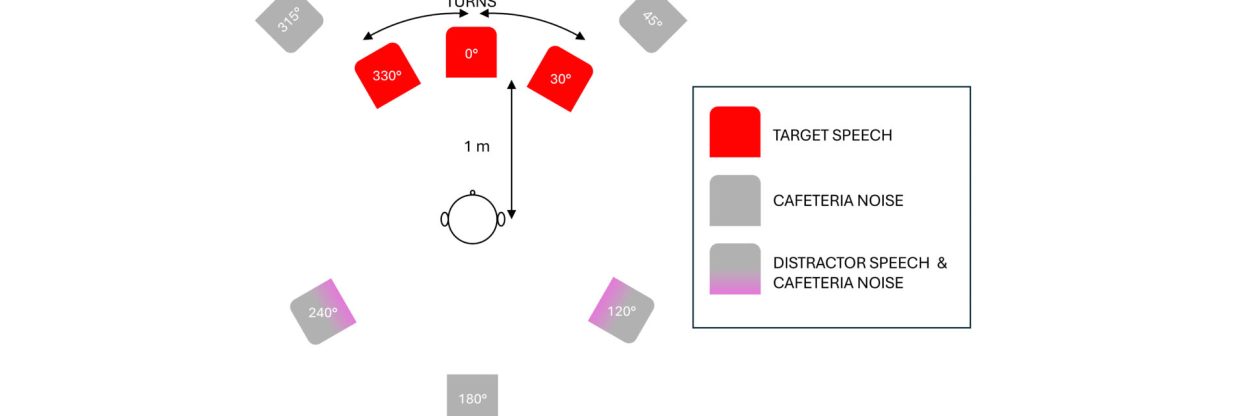
The HearingReview, December 11, 2024
Read more

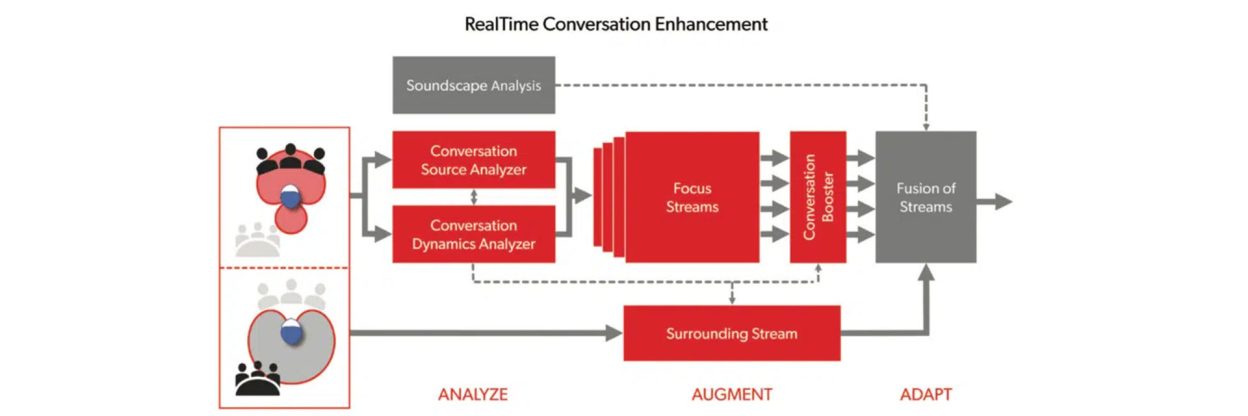
The HearingReview, September 5, 2024
Read more
American Journal of Audiology, July 10, 2024
Read more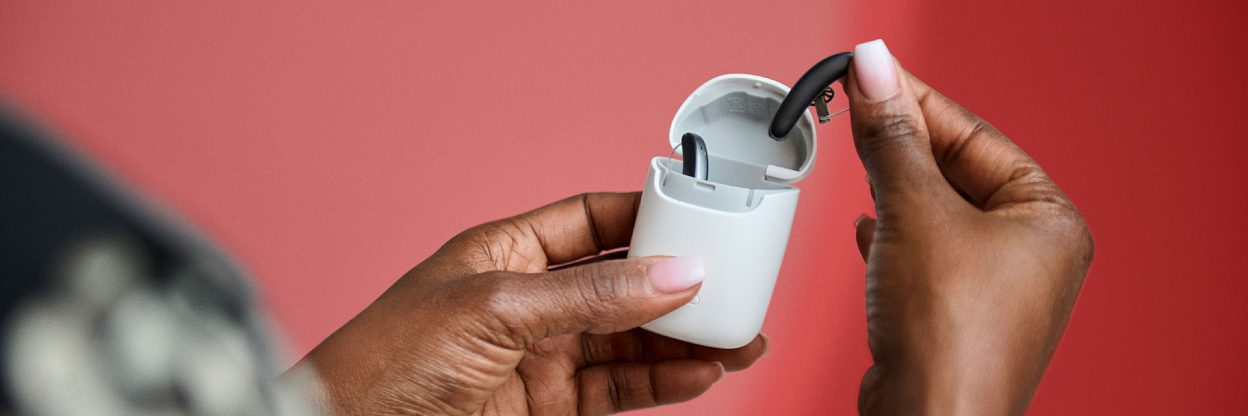

The Hearing Review. May 9, 2024
Read more

Hearing Review, November 03, 2023
Read more

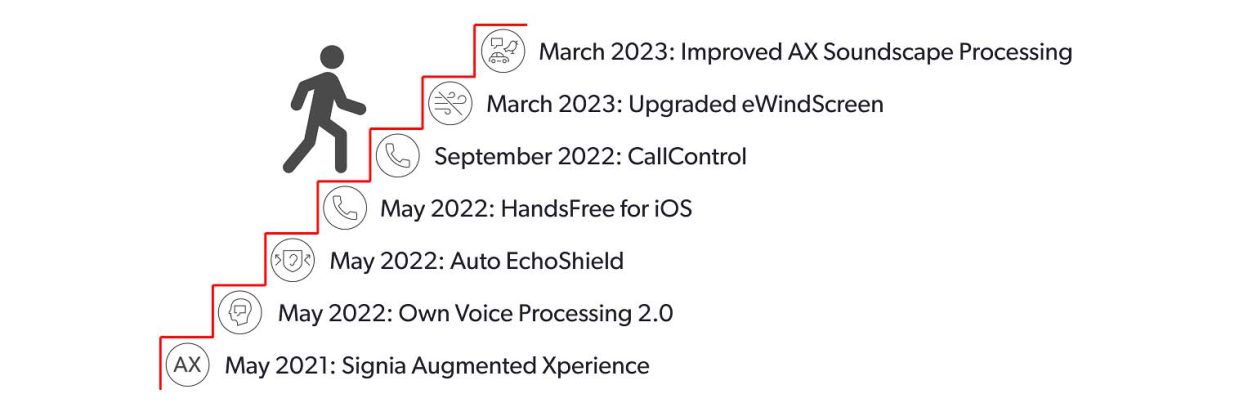
The Hearing Review, May 9, 2023
Read more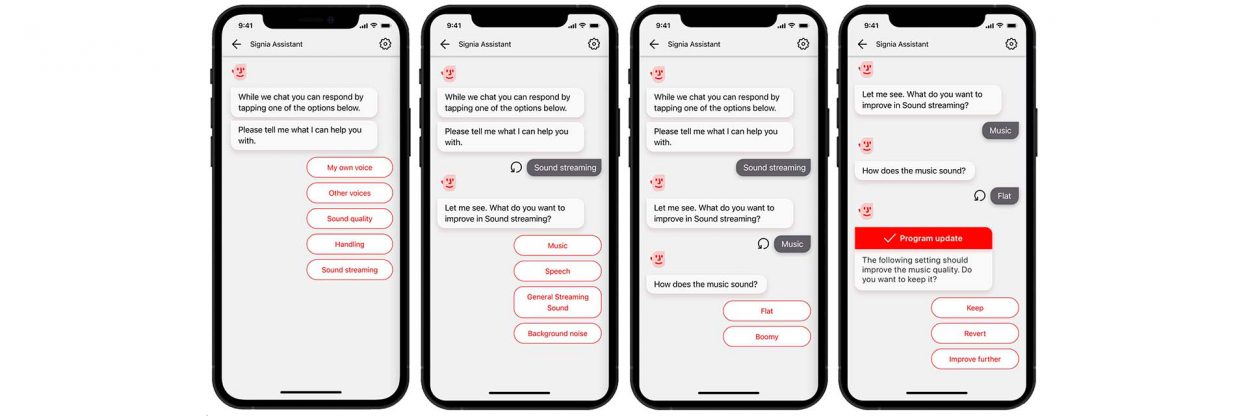
Audiology Online, April 3, 2023
Read more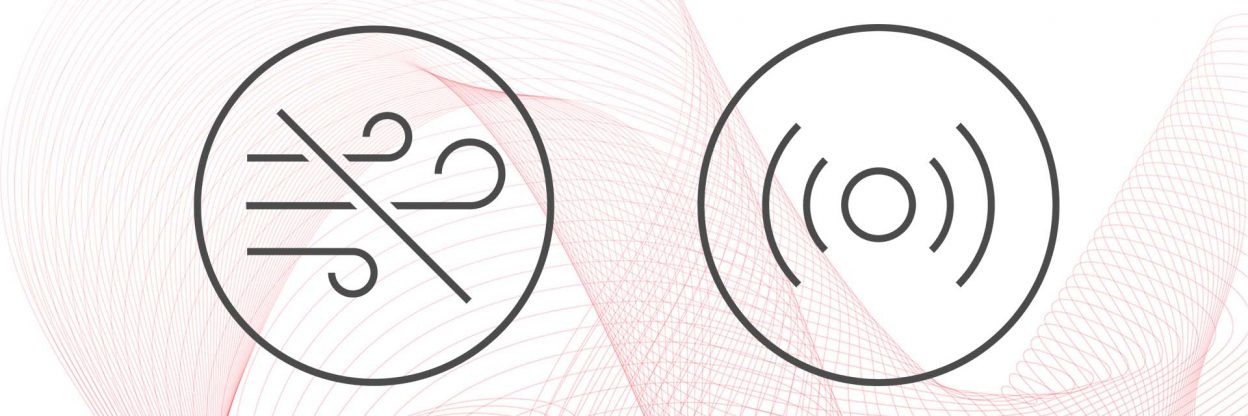

Hearing Review, January 12, 2023
Read more
This paper presents the outcome of a study investigating the Signia Augmented Xperience (AX) HandsFree for iOS and CallControl functionality that allows wearers to conduct hands-free phone calls.
Read more
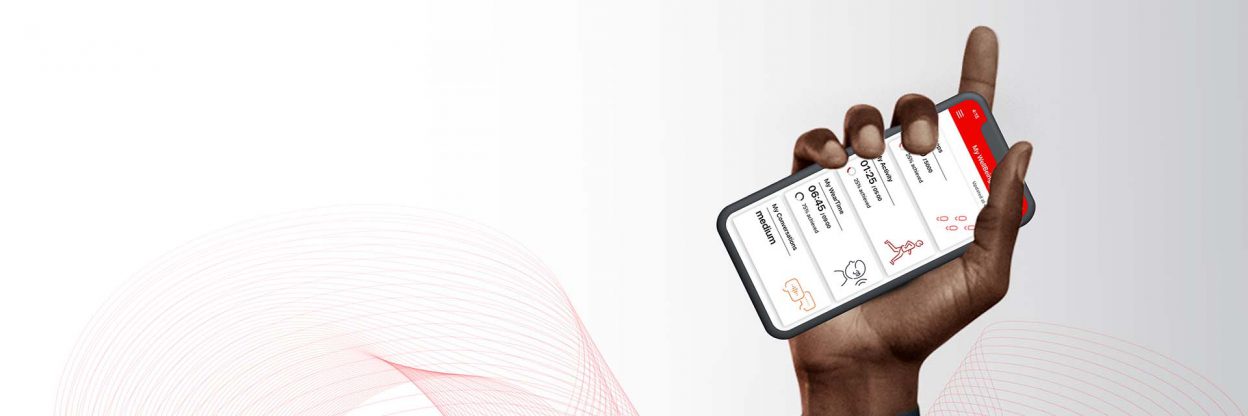

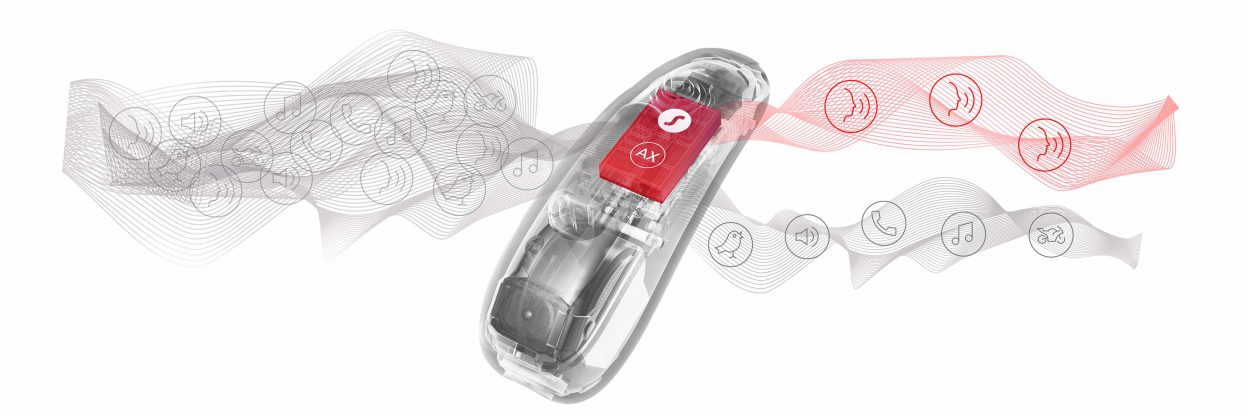

Bluetooth enabled hearing aids with direct streaming functionality allow hearing aid wearers to hear a conversation partner on the phone directly via their hearing aids. Now, the new Signia AX HandsFree Mode enables iPhone users to make handsfree phone calls, eliminating the need to use the smartphone’s microphone to pick up the wearers voice.
Read more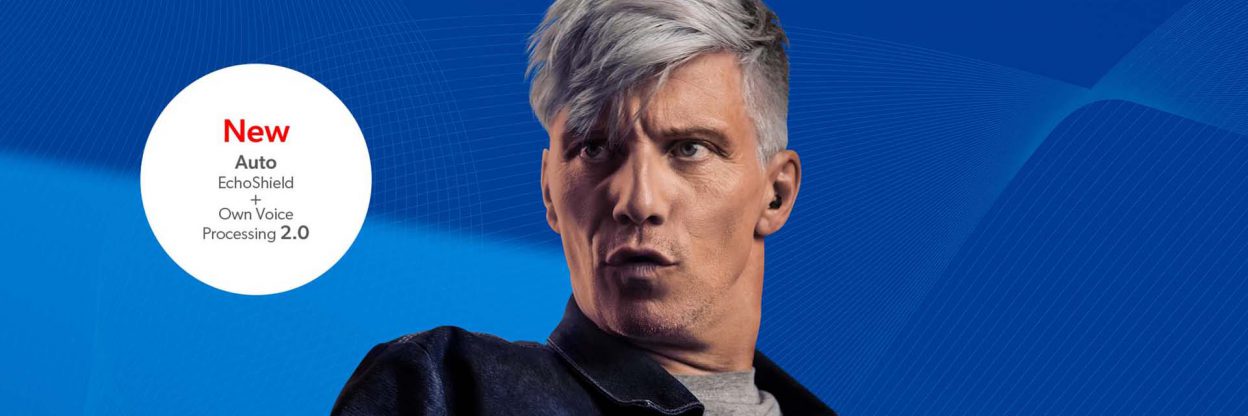
Signia AX, introduced in 2021, is a significant departure from traditional signal processing found in other hearing aids, and it addresses the most common problem associated with hearing aid use: performance in background noise
Read more
Auto EchoShield in Signia Augmented Xperience (AX) hearing aids addresses the situation where a hearing aid wearer is present in a room with reverberation caused by multiple sound reflections (echoes) from the room surfaces, for example in a church or entrance hall.
Read more
Since its introduction, Own Voice Processing (OVP) has been a unique technology only offered by Signia, preserving the familiar sound of the hearing aid wearers’ natural own voice.
Read more
Signia commissioned Ramboll a/s to conduct a life cycle assessment (LCA) study in accordance with ISO standards 14040 and 14044 for two comparable hearing aid devices and their respective battery solutions, i.e. a primary, non-rechargeable battery and a secondary, rechargeable battery. The overall aim was to investigate and understand the environmental impacts of two comparable hearing aid devices with different battery solutions. The two products chosen for assessments are rechargeable Signia Augmented Xperience (AX) and non-rechargeable Signia AX.
Read more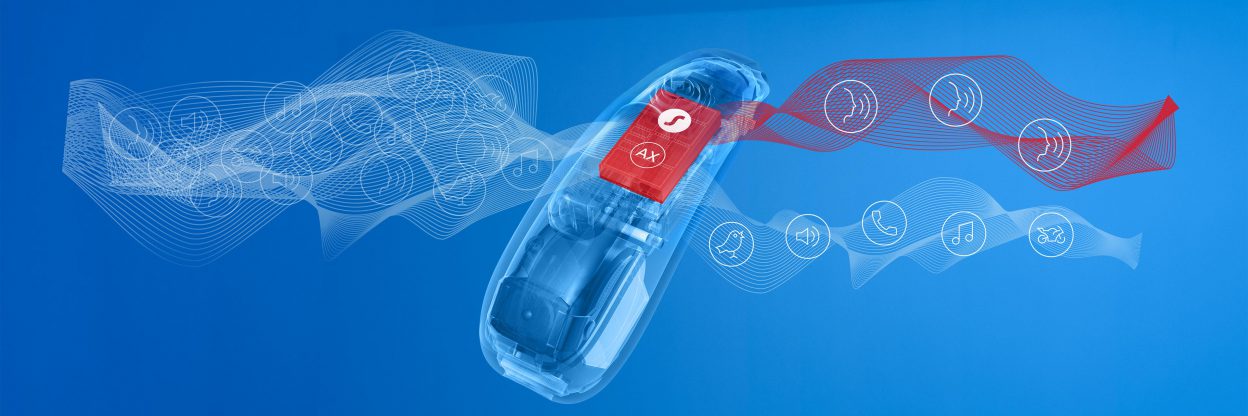
Recently, Signia introduced the AX platform of hearing aids to take the next step managing and augmenting the listening experience. The AX platform builds on former platforms, but also incorporates new approaches to processing. Part of the AX development was to look at how other industries approach sound and explore opportunities to expand on previous approaches.
Audiology Practices 13(4), 36-41.
Read more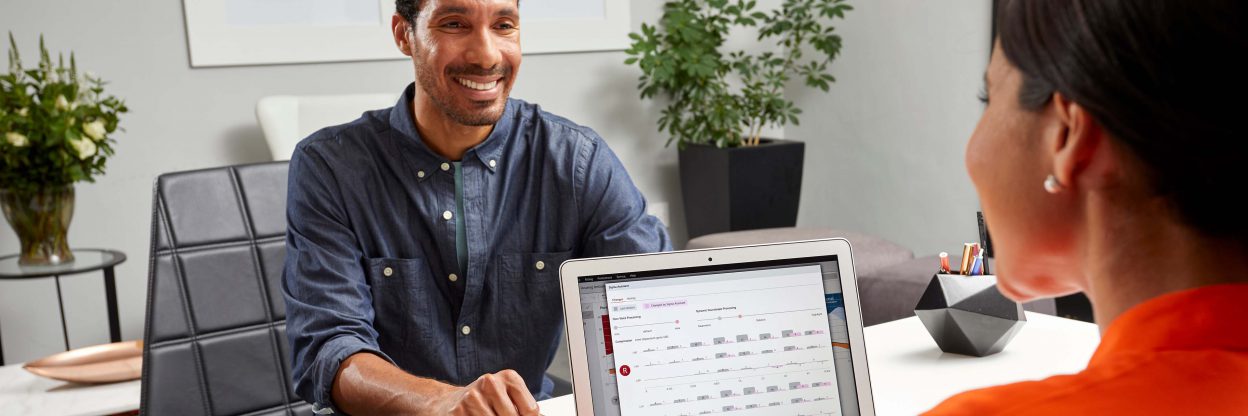
To investigate the benefits of an AI assistant to support the individualization of hearing aid fittings, 58 hearing aid wearers were surveyed. The results showed Signia Assistant is perceived as easy to use and improves the fitting for individual wearers in difficult listening situations. Further, it increases the clinician’s ability to optimize the fitting more accurately to the individual and strengthens the provider-wearer relationship.
The Hearing Review, Nov 1 2021
Read more
The combination of acoustic and motion sensors provides the hearing aids with data to better optimize the hearing aid features in anticipation of the hearing aid user's listening needs.
Seminars in Hearing, September 24, 2021
Read more
Signia has a long track record of developing innovative amplification features that optimize wearer performance in all types of challenging listening situations. The goal of optimizing wearer performance across a range of divergent listening conditions was the main driver in the development of the Signia Augmented Xperience (AX) platform with the revolutionary Augmented Focus™ technology.
Audiology Online, September 1, 2021
Read more
Understanding the principles of our unique and patented Augmented Focus technology is easy, when the methods the brain uses to focus on sound inputs are considered.
Read more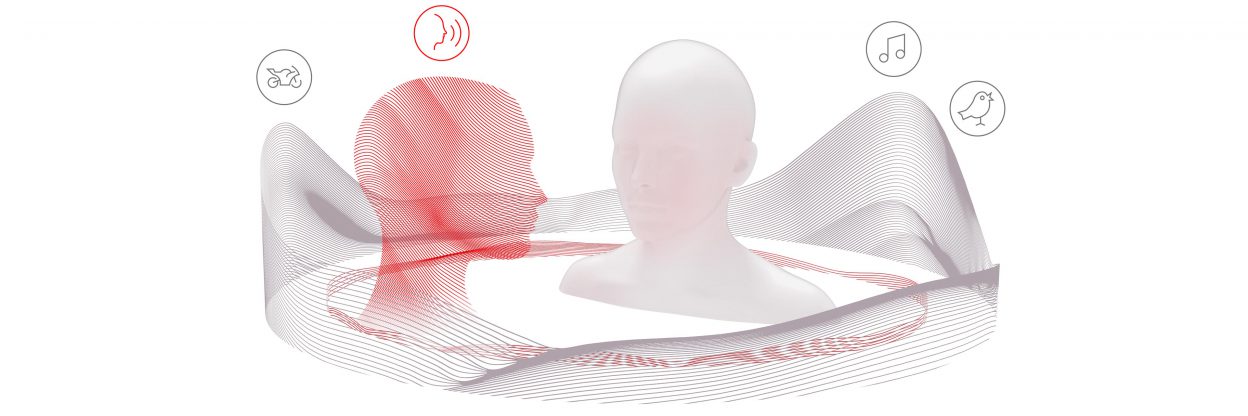
To test the wearers’ experience of Signia AX in real-world listening situations, an international survey was done in which respondents were fitted with Signia AX devices and then assessed the devices in their everyday life and compared the performance to that provided by their own hearing aids. In this white paper, we present preliminary data from the US part of the survey. The data indicate high levels of satisfaction with AX in a variety of listening situations and a clear preference for AX over the respondents’ own hearing aids.
Read more
Due to the restrictions dictated by the COVID-19 pandemic, a fully remote study of Signia AX was done in collaboration with Hörzentrum Oldenburg in Germany, involving both fitting and assessment of Signia AX being done in the participants’ own homes. The results showed high levels of immediate satisfaction with AX just after the fitting, and in an at-home speech-in-noise test, the new Augmented Focus processing allowed the participants to perform significantly better with AX than with their own hearing aids.
Read more
In a study at the University of Northern Colorado, the performance of Signia AX was tested in challenging communication situations simulated in the lab. The results showed that activation of the new Augmented Focus processing significantly improved the participants’ ability to understand speech in a restaurant scenario. Furthermore, the speech-understanding performance exceeded that offered by two main competitors and was on par with the performance of a normal-hearing reference group. In a simulated party scenario, the performance with AX was even better than normal-hearing performance when binaural beamforming was activated.
Read more
The white paper discuss important aspects of fitting hearing aids to people with severe to profound hearing loss in general, and specifically highlights the new features in Signia Motion C&G SP X supporting and innovating this field, also supported by study results.
Read more
A survey of 56 hearing aid users compared users’ satisfaction between Xperience and their own hearing aids, showing higher satisfaction ratings for Xperience across the board. The advantage for Xperience was especially pronounced for listening situations where the integrated acoustic-motion sensors, advanced directionality and noise reduction of the Xperience instruments help users lead their lives. These satisfaction ratings are compared to norms from MarkeTrak and EuroTrak, showing that even though hearing aid satisfaction is generally quite high, the Xperience instruments stand out.
Read more
The use of masks and increased distancing while talking because of the coronavirus pandemic is a unique challenge that can be very frustrating even for people with normal hearing. But for the hard of hearing it can prove especially difficult. Signia offers flexible solutions for you as a Hearing Care Professional (HCP) to optimize speech intelligibility in this “new normal” world. This new audiology bulletin explains the adverse effects of masks and social distancing on speech understanding and how HCPs can improve their clients’ hearing experience with the right advice and program settings in Connexx.
Read more
Times are changing and the need for new tools to provide support has never been higher. The Signia Assistant is founded on over 130 years of audiological experience and trust in the hearing care professional. Build on the Artificial Intelligence technology Neural Networks, it’s able to identify which adjustment suits the current environment best, based on both global and individual learning. For the user it means they can tailor their sound to meet their everyday situation, for the HCP it means a completely new insight tool into their wearer’s real world experience and use of the hearing aids. Relevant for the special situation we’re facing globally: The Assistant is also able to support with handling and troubleshooting and can act as the extended arm of the HCP. In this white paper, the Assistant is put to the test. Let’s see how it performs is real world user studies.
Read moreThe Signia Assistant is the modern tool for the modern HCP and wearer. Learn more about how it actually works and why it provides a huge benefit both to the HCP and the end-user. The innovation is more relevant than ever at times when physical clinic visits are not feasible in many cases.
Read more
This paper describes in detail how to use the Signia Assistant, both in the Signia App and in Connexx for Hearing Care Professionals.
Read more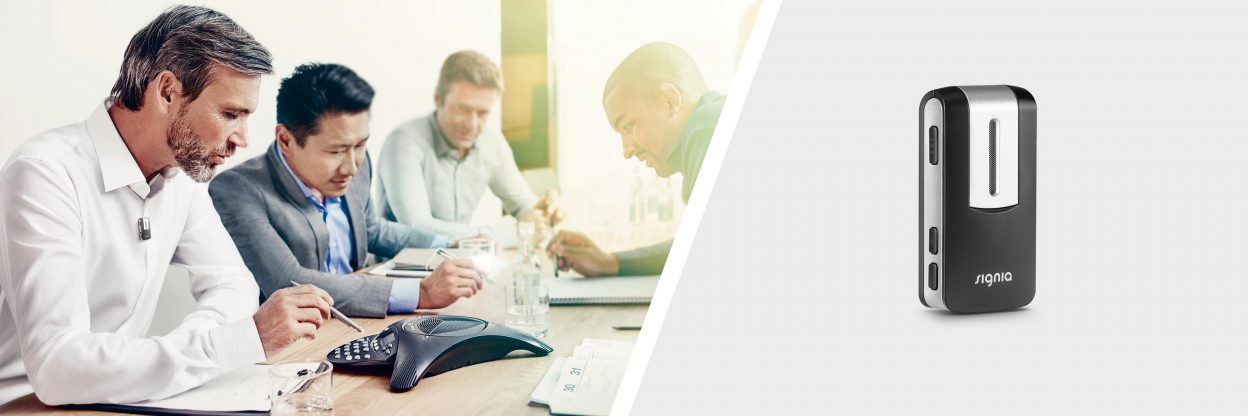
The StreamLine Mic from Signia is a versatile Bluetooth streaming device and remote microphone all in one. Its Bluetooth functionality allows it to pair to multiple Bluetooth enabled devices including Android and iOS (Apple) devices. And the remote microphone capabilities help make even though most difficult listening situations easier to manage. This white paper examines advantages and the performance of the StreamLine Mic
Read more
Options to offer services and solutions based on electronic processes and communication have in recent years been increasingly explored within the entire healthcare industry. Depending on the specific processes and technologies involved, such solutions are often referred to using umbrella terms like eHealth, mHealth, connected health, telemedicine or telehealth, but more field-specific terms have also been introduced.
Audiology Online
Read moreSignia Xperience takes the next step in designing hearing aid technology that “thinks” the way the listener thinks, and automatically adjusts processing accordingly. Study data reveal significantly better speech understanding for speech from the sides, both when stationary and when moving. Speech-in-noise recognition research shows that the new Dynamic Soundscape Processing does not reduce the effectiveness of Narrow Directionality for speech coming from the front. And finally, real-world data reveal highly satisfactory environmental awareness, and higher overall user satisfaction ratings than have been obtained in published large-scale surveys.
Audiology Online
Read moreYourSound technology is a comprehensive steering system that was introduced with the Xperience platform, designed to optimize aided performance in any listening situation for the individual user. Connexx offers access to the system in order to allow further individualization when needed. This How-To provides guidance on the exact procedure.
Read more
Since its introduction with the binax platform in 2014, Signia’s Narrow Directionality has been the industry leader in optimizing speech understanding in background noise. The purpose of the current research was to ensure that the Narrow Directionality feature of the Xperience was equal to that of the Nx model—previous research has shown that the speech-in-noise processing of the Nx is superior to that of premier models from competitive manufacturers. Indeed, the results of this research revealed that there was no difference in the speech recognition findings for the two different instruments. This allows us to reasonably assume that Xperience also is superior to the competition for these important listening conditions. For those who were questioning if it is possible to obtain excellent soundscape processing for speech, while still maintaining a high level of narrow directionality, the answer is yes.
Canadian Audiologist, VOL. 6 • ISSUE 6 • 2019
Read more
Signia Xperience devices take a significant step towards adapting to the listening intent of the wearer. YourSound technology is the realization of this comprehensive approach, consisting of the sensory analysis layer provided by Acoustic-Motion Sensors, the processing of environmental sounds in the Dynamic Soundscape Processing, and the Own Voice Processing to process the microphone input as soon as the system detects that the wearer is speaking. This article provides insights into the different components of YourSound technology.
Read more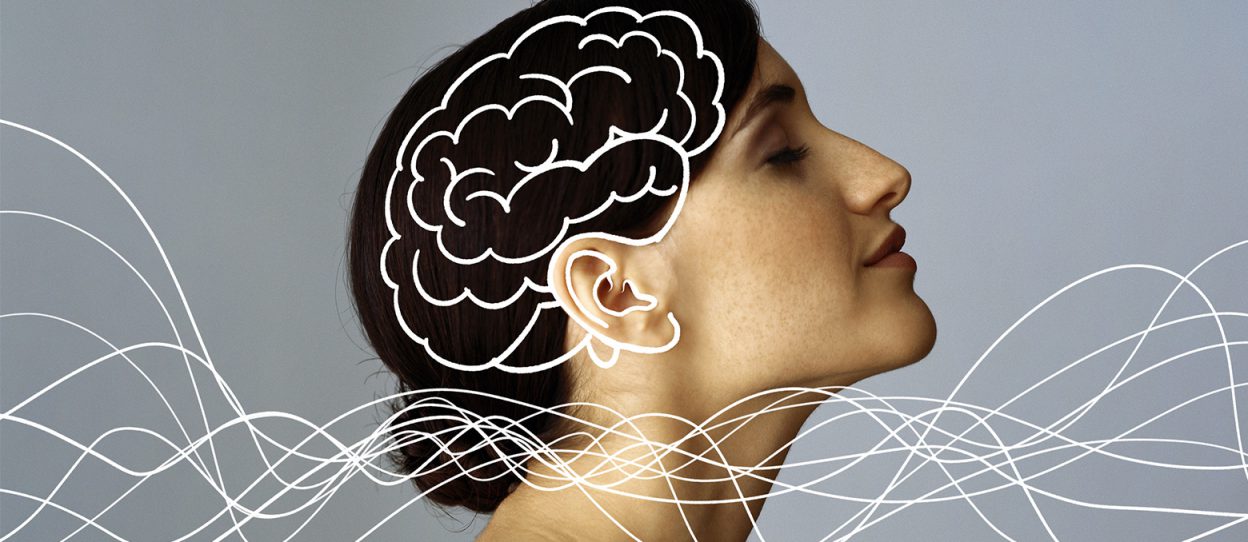
It is important that the design of hearing aid processing closely resembles the listening intent of the user. This has been enhanced with the Signia Xperience, which utilizes new acoustic and motion sensors, serving to improve speech understanding and the acoustic sound scape. Laboratory data shows significantly better speech understanding for speech from the sides, both when stationary and when moving. Real-world studies using EMA methodology revealed highly satisfactory environmental awareness, and higher overall user satisfaction ratings than have been obtained for either EuroTrak, or the recent MarkeTrak10. Overall, for both efficacy and effectiveness, the performance of the Signia Xperience hearing aids was validated, and increased patient benefit and satisfaction is expected to follow.
The Hearing Review, November 7, 2019
Read more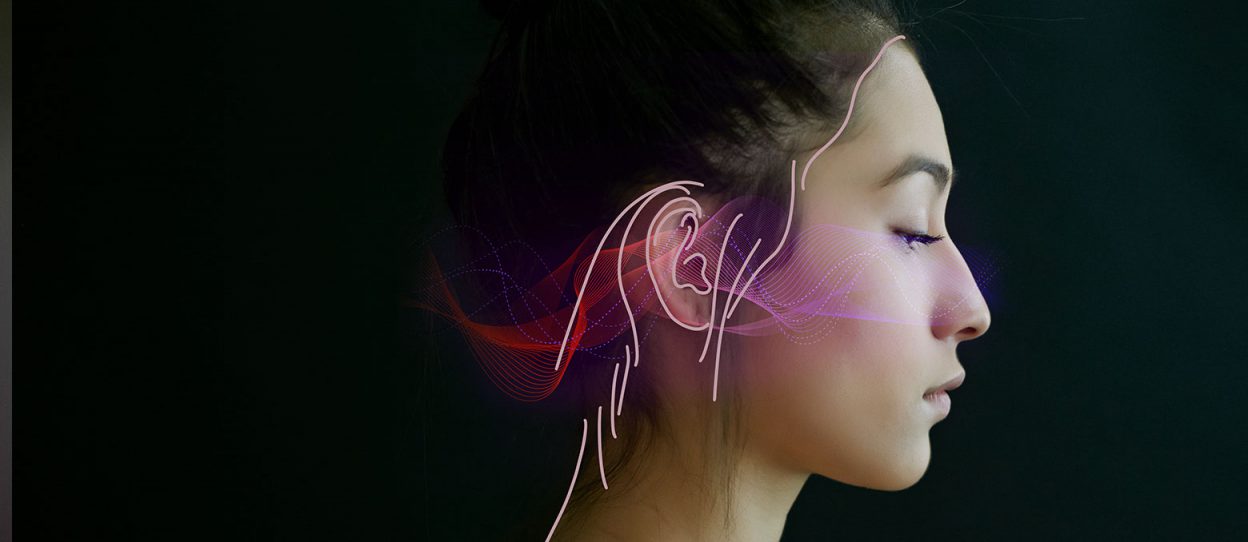
This study demonstrates the benefit of partial masking, encouraging patients to seek help from audiologists interested in providing support for tinnitus patients. Thirty-three percent of our participants with bothersome tinnitus benefited from maskers provided through Signia instruments without any counseling whatsoever. Within that responsive group, 38–75% of them experienced improved quality of life in the domains of thoughts and emotions, sleep, concentration, and hearing.
Jun 14, 2019
Read more
A large portion of individuals with dementia also have hearing loss. When these patients are fitted with hearing aids for the first time, the use and operation of the instruments can be a struggle, and the struggle often carries over to their caregivers. This research found that the use of teleaudiology via Signia TeleCare for these new hearing aid users increased awareness, improved benefit for several different communication settings, and reduced associated stress for the caregivers.
May 21, 2019
Read more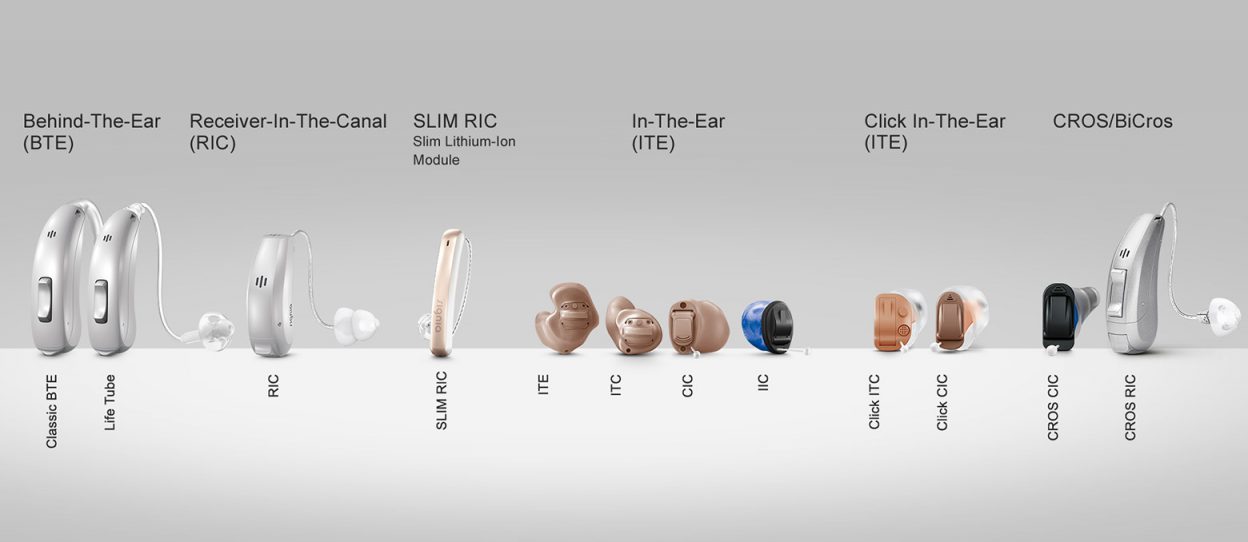
Premier hearing aid products from three leading manufacturers were placed in head-to-head competition to assess key benefits for the wearer. For the speech recognition measures, the Signia product was significantly superior, and this was true for three different background noise conditions. Subjective judgements for different attributes of the listening experience were equal for the three products, suggesting that superior speech understanding can be achieved without causing negative effects regarding the acoustic environment.
VOL. 6 • ISSUE 4 • 2019
Read more
One of the main concerns of Hearing Care Professionals (HCPs) who are fitting and dispensing hearing aids is knowing how to achieve excellence in patient service. A study involving 88 HCPs and more than 5600 first time users revealed the benefit of Signia TeleCare in creating higher hearing aid adoption rates with patients. The use of TeleCare was also found to result in high user satisfaction ratings in all the most relevant hearing situations for the individuals. The findings showed that a careful and consistent implementation as part of the HCP’s patient care workflow was key to leverage the remote care potentials provided by Signia TeleCare.
Read moreThe findings of this research clearly show that the coupling system chosen by the HCP can have a substantial effect on subsequent speech understanding in background noise for the patient. The mean additional signal-to-noise ratio (SNR) benefit for a closed fitting was 3 dB, which corresponds to an impressive improvement in speech understanding of approximately 50%. This constitutes a significant advantage for the patient’s daily life in terms of social interaction. This benefit should not easily be foregone, especially in light of the clinically proven high acceptance of closed fittings based on the patient’s improved perception of his or her own voice as a result of Signia Own Voice Processing.
The Hearing Review, March 21, 2019
Read moreThis study supports the idea that modern hearing aid technology improves patients’ quality of life to a greater extent than shown in previous studies. While it is not possible to determine the degree of the direct relationship, it appears that Own Voice Processing leads to talking more in important communication situations, and in turn, this helps lead to the improvement.
January 10, 2019
Read more
Today’s hearing aid fitting and counseling session should extend beyond the traditional hearing aid fitting & counseling protocol, in order to ensure user satisfaction in daily life right from the start. Exploring the benefits of Bluetooth technology and counseling regarding realistic expectations should therefore be routinely provided prior to leaving the Hearing Care Professional’s office. The paper gives detailed guidance how to conduct such an assessment for all manufacturer’s Bluetooth hearing aids, with further tips for Signia products utilizing manufacturer specific tools and features.
Read more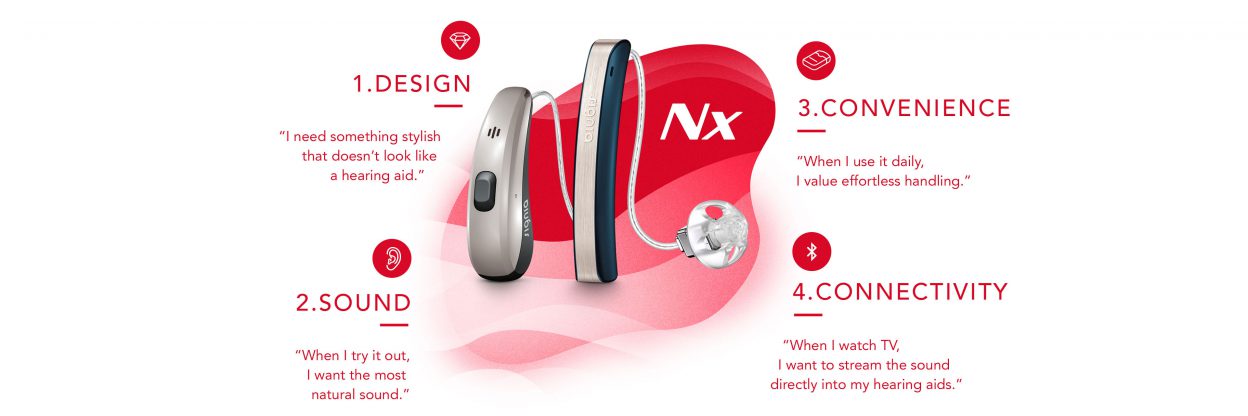
Few manufacturers offer technology that incorporates both bilateral full-audio sharing of signals as well as direct streaming from a mobile device. In a comparative research project, the effectiveness of the streaming for such hearing aids was evaluated. The findings reveal a crucial difference between streaming indoors and outdoors, which is important to consider when counseling patients. Results show a substantial streaming advantage for the Signia product, and indicate that a Bluetooth based wireless approach as applied by the competitor brand does not deliver on all basic user needs.
Read more
In an AmpCROS or TriCROS set-up, the aid on the poorer hearing side picks up the sound, amplifies it, and delivers it to both ears. The aid on the better hearing ear receives an amplified signal from the contralateral side and combines it with the ipsilateral signal. This short guide shows you how to use Signia NxTM instruments for an AmpCROS fitting.
Read more
Our goal at Signia has always been to allow our patients to live their lives to the fullest despite hearing loss. Therefore, we develop hearing solutions designed to ease and facilitate communication in a variety of listening situations. This paper describes several of our advanced features on the Nx platform and corresponding studies that demonstrate clinically proven benefit to patients.
Read more
This Hearing Review article presents a study which demonstrates that the two new CROS/BiCROS systems from Signia—Pure 312 Nx CROS with Narrow directionality and Silk Nx CROS—provide a superior solution to the daily listening problems encountered by people with single-sided deafness (SSD).
Hearing Review
Read more
It’s debatable whether a computer will ever “think” in the same way that the human brain does, but machines’ abilities to see, understand, and interact are changing our lives. It is no surprise then, that in the past few years we have seen mention of machine learning in hearing aid trade journal articles. But are machine learning hearing aids really something new?
Read more
In a real-world field study, the Hearing Profile was shown to be a valuable tool for hearing care professionals, not only by providing an individualized first fit with an appropriate target prescription, but also a means to leverage the cooperation between professionals and patients which results in improved fitting success.
AudiologyOnline
Read more
The latest study shows that the streaming audio quality of the Signia Nx ITC instruments have achieved “best-in-class” audio streaming as compared to the only competitive custom streaming device.
Canadian Audiologist
Read more

How do we know that Styletto is an industry game-changer that will attract new wearers who would never have considered hearing aids before? We asked them! Read this paper to learn more.
Read more
This clinical study shows that AutoFit is both valid and reliable, and can be an efficient and useful tool in the verification of the hearing aid fitting via the new IMC2 standard.
Hearing Review
Read more
Patients with SSD often experience significant problems with speech understanding in daily listening situations where noise is a factor. The results of this study demonstrate that the two latest CROS/BiCROS solutions offered by Signia, the Pure 312 Nx CROS with Narrow Directionality and the Silk Nx CROS, provide clear and significant speech intelligibility benefits for users in challenging listening environments.
Read more
AutoFit™ is a beneficial feature in the Connexx™ Fitting Application that automatically provides the Hearing Care Professional (HCP) with an optimized real-ear insertion gain (REIG) setting without the need for the HCP to manually match targets. This paper describes how to perform quick match-to-target fittings using AutoFit from Connexx Version 8.5 onwards.
Read more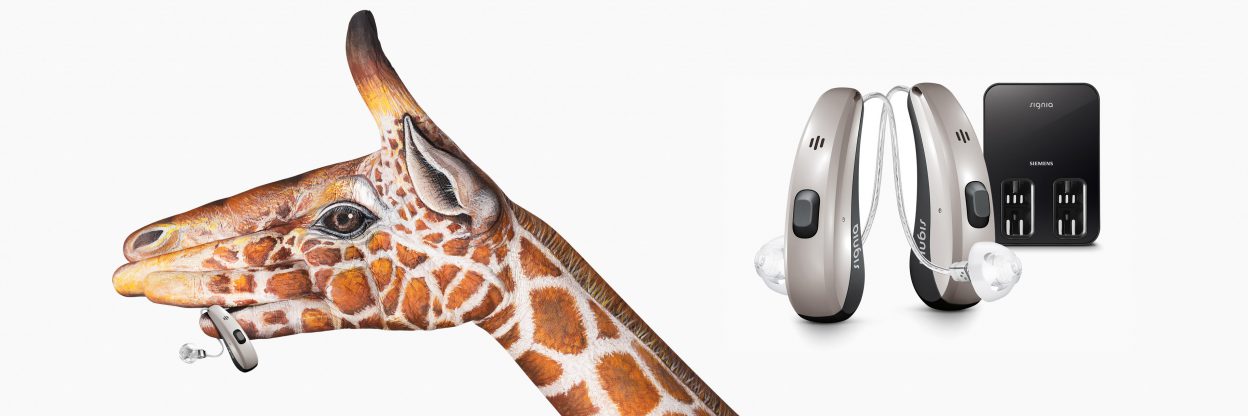
How does Pure Charge&Go stack up against leading competitor hearing aids? A study was conducted in April 2018 with 100 participants to find out.
Read more
OVP improves the perception of the the wearer's own voice, but did you know that a recent study shows that it also has wearers participating more in communication settings?
Hearing Review
Read more
At first glance, a tiny hearing aid and a self-driving car don’t have much in common. However, on a technological level there are a couple of similarities: self driving cars use a variety of sensors to collect real-time information about the environment such as GPS, optical cameras, specialised radar, and accelerometers.
Read more
An increasing number of wearers are relying on Bluetooth to stream phone calls to their hearing aids. Some options on the market which feature streaming to both ears contend that the bilateral signal fosters better speech intelligibility, but is this supported by research evidence, or just conjecture?
Read more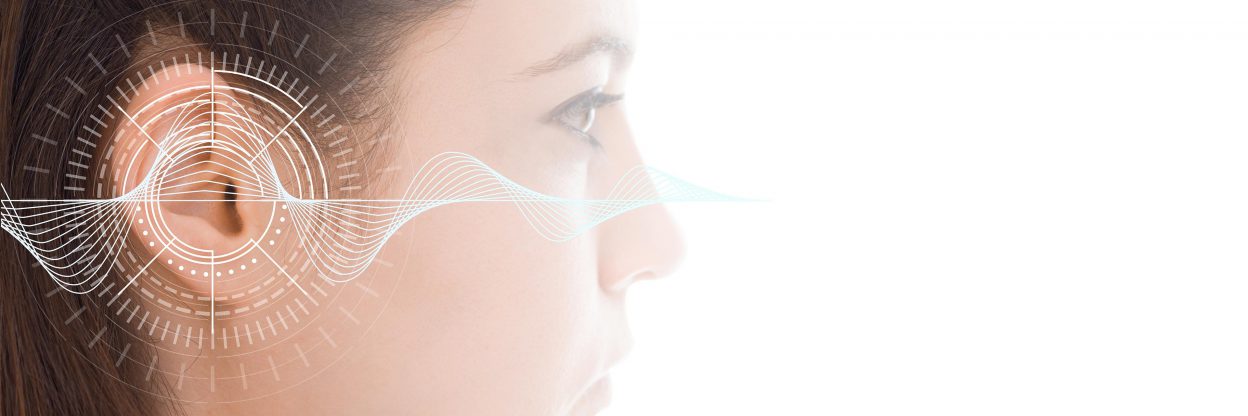
We have been taught that the occlusion effect often is the culprit in own voice issues, so why is it that with the prevalence of open fittings, patient dissatisfaction with the sound of their own voice is still an obstacle to hearing aid acceptance?
Read more
This Hearing Review publication reports on a study which uses three tests to evaluate the various aspects of hearing aid performance directly affected by the FBC: Aided Gain Before Feedback, Max-REIG, and a sound quality evaluation using Multi-Stimulus Test with Hidden Reference and Anchor (MUSHRA). Considering all potential trade-offs, the Signia FBC can be considered a best-in-class algorithm in this multifaceted benchmark analysis.
Hearing Review
Read more
A study conducted at the University of Northern Colorado shows that OVP is appropriate for both open and closed fittings, and for different fitting rationales.
AudiologyOnline
Read more
Connectivity is undoubtedly one of the most im-portant topics in the hearing aid industry today. While most people immediately associate the word connectivity with being able to link their hearing aids with electronic devices such as smartphones, in a genuinely patient-centric hearing system the ap-plication of connectivity encompasses more than simply connecting to personal electronic devices.
Read more
This AudiologyOnline article describes Nx improvements in sound quality.
AudiologyOnline.com
Read more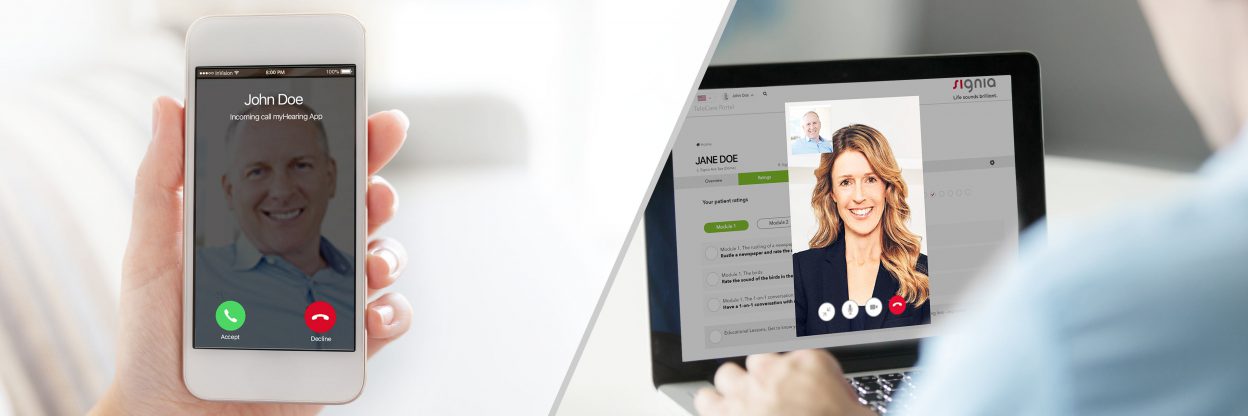
Since the introduction of TeleCare, anonymous analytics data shows that there have been more than 150,000 patient-professional interactions around the world, including 5,000 remote tuning interactions. With this large amount of data available, valuable insights can be deduced to help hearing care professionals improve their service and business success. Learn what Signia TeleCare can do for your practice and what's new with version 3.0.
Read more
We have designed a new innovative ready-made ITE product called Silk. Along with this product is the introduction of especially designed click sleeves. This new product capitalizes on the successful components of the RIC fittings, so that similar patient benefits can be obtained with ITE products.
Read more
This Hearing Review publication describes how Own Voice Processing works and details study results validating its effectiveness.
Hearing Review
Read more
The myControl App 2.0 provides the wearer with a convenient way to control their Signia Bluetooth hearing aids according to their needs as well as to monitor their hearing performance closely.
Read more
The myControl App 2.0 provides the wearer with a convenient way to control their Bluetooth direct-streaming hearing aids as well as to monitor their hearing performance closely. Here is how to use the app.
Read more
Signia Nx hearing aids solve the own voice issue with a sophisticated technological solution—a real-time detection of the wearer’s voice, combined with dedicated Own Voice Processing (OVP). To use OVP, the patient must perform a short customization procedure during the initial hearing aid fitting. Here is how to do it.
Read more
When working with Signia Nx Bluetooth hearing aids such as Pure Nx, TeleCare 3.0 turns the patient’s Apple or Android smartphone into a programming interface, and enables full remote programming functionality via Connexx. Here is how to do it.
Read more
A high level of sound quality is vital for new hearing aid wearers who have to adapt to hearing the world via an electronic device. This is especially important for the sound quality of the wearer’s own voice. Hearing care professionals often resolve own voice complaints by reducing amplification, with the unintended consequence of decreased speech intelligibility. With the new Signia Nx, this is no longer an issue—because of the revolutionary technology called Own Voice Processing (OVP).
Read more
Since the introduction of TeleCare, anonymous analytics data shows that there have been more than 150,000 patient-professional interactions around the world, including 5,000 remote tuning interactions. With this large amount of data available, valuable insights can be deduced to help hearing care professionals improve their service and business success. Learn what Signia TeleCare can do for your practice and what's new with version 3.0.
Read more
While hearing aid users often wear their hearing aids for music listening, they are frequently dissatisfied with the sound quality of music. This AudiologyOnline article details a study which describes music sound quality ratings between the universal and music programs of five premier market hearing aids, and which hearing aid achieves the best overall sound quality ratings.
AudiologyOnline, August 2017
Read more
It has long been known that pure tone audiogram (PTA) measurements cannot fully account for the variation in speech intelligibility scores measured from hearing impaired listeners. With regard to hearing aid fittings, it is clear that there is no simple solution that would allow us to perform a consistently perfect customized fitting by even adding one additional variable to audiogram data. A transition from the “average” patient fitting towards a more individual fitting requires several stages. In this paper, these stages are described and explained, based on data obtained from several clinical studies.
AudiologyOnline
Read more
This Hearing Review publication reports that Signia OVP provides a substantial improvement in own-voice satisfaction, and that this improvement is present for different fitting strategies, and for different ear-canal couplings.
Hearing Review
Read more
Study shows that Signia Pure 13 BT consistently received the highest mean ratings compared to the average of the four competitor products. This advantage held true for five different genres of music and for a streamed mobile phone speech signal. Signia Pure 13 BT also was rated considerably higher than the other products regarding annoying artifacts.
Canadian Audiologist, Vol. 4, Issue 4, 2017
Read more
Listening to music is important for most hearing aid users, and, having a high quality signal is essential. Using the MUSHRA methodology, samples of music were rated for the premier instrument from four leading manufacturers. Data analysis revealed significantly higher ratings for Signia primax for both the universal program and for the music program. The superiority was present regardless of music genre, or whether the music sample was familiar or unfamiliar.
Read more
The second generation of TeleCare builds up on the success of TeleCare 1.0 to improve the link between the HCP and the user.
Read moreThis article examines the advantages provided by the Signia primax Narrow Directionality processing for speech understanding in background noise in four studies: Comparisons of the primax system to previous research with the binax platform, SNR benefits related to average speech understanding, and comparisons to a competitive product using Signia adaptive directional and narrow directionality processing.
The Hearing Review, May 2017
Read moreTaking advantage of the powerful computers we carry around in our purses and pockets – our smartphones – hearing instruments have just reached a new level of precision. By adding information from the motion sensors in our smartphones through Bluetooth (BT), Signia Pure 13 BT can detect the wearer’s listening situation in a much more sophisticated way.
Read moreThe new Performance Guide in Connexx 8.3 is an integrated tool which recommends hearing aid performance levels that fit the patient’s needs best. It is a tool which can be used during the initial consultation, as well as after home trials.
Read more“Direct streaming” describes transmitting an audio signal from a mobile device to a wearer’s hearing aids - without using an intermediate accessory to relay the signal. Direct streaming is the most desirable streaming technology available for hearing aids, and has become even more important because of increasing usage of smart phones.
Read more“Connectivity” is a word that is used a lot in today’s society, and for good reason. Whether we are connecting with friends and acquaintances on Facebook, using our smartphones to connect to media and news websites, or checking the weather, the theme of connectivity plays a big part in most people’s lives.
Read morePure 13 BT is the first solution that marries the until-now separate worlds of hearing instruments and advanced smartphone technology to improve signal-processing. With the new myControl app from Signia, the hearing aids can access information from the wearer’s smartphone, enabling them to detect the acoustic environment and anticipate the listener’s intent and preferences more precisely than ever before. The hearing aids cannot know for certain what the wearer wants to hear, but with the movement information, they can predict it with better accuracy. In addition, the user can control their instruments, monitor their acoustic environment and, of course, stream directly from their iPhone or iPad.
Read moreConnexx 8.3 offers a new functionality called Hearing Profile designed to further individualize first fit for each patient. This feature uses a short sound quiz and questionnaire to quickly assess the cognitive functions and preferences of the patient. The resulting personal hearing profi le is combined with the patient’s audiometric data to propose one out of five first fit configurations when using primax fit. This precision first fit promotes better spontaneous acceptance and reduces the need for extensive fine tuning.
Read moreSignia TeleCare is the world’s first telehealth tool that instantly connects hearing aid wearers with their hearing care professionals (HCP). By bringing patients and professionals closer than ever before during the critical home trial period and beyond, TeleCare helps patients stay satisfied with their new hearing aids even after they leave the office, and helps HCPs save time and differentiate their practice.
Read moreThe myControl app provides the wearer with a convenient way to control their Bluetooth directstreaming hearing aid Pure 13 BT (1). The myControl app is available for Apple mobile devices (iOS 9.3 and onwards), and can be downloaded free of charge from the App Store.
Read moreThe myControl app provides the wearer with a convenient way to control their Bluetooth ® directstreaming hearing aid Pure 13 BT. The myControl app is available for Apple mobile devices (iOS 9.3 and onwards), and can be downloaded free of charge from the Apple App Store.
Read moreAs digital hearing aids become increasingly advanced, the spotlight often shines on signal processing features, software functionality, and connectivity capabilities, rather than the physical components. At Signia, however, we constantly seek to improve every aspect of design, engineering, and production processes to create a better hearing aid. The new Click Sleeve for Receiver-in-Canal (RIC) fittings is a seemingly simple yet effective solution which improves both wearer comfort and audiological performance.
Read moreStudy shows that adding a dereverberation program found in the Signia Primax RIC, improved speech intelligibility and reduced listening effort in the majority of the listeners tested using simulated reverberation.
Read moreTinnitus and hearing loss often go hand-in-hand. For those patients whose tinnitus is not mitigated by amplification alone, Signia hearing aids offer hearing care professionals three types of tinnitus therapy approaches to customize for each patient. Static Noise and Ocean Wave signals are both sound therapy approaches that have been proven to provide relief for many tinnitus patients, especially when combined with established therapy approaches.
Read moreA review of clinical studies from three leading hearing aid research centers show a consistent trend for the Signia primax features to significantly reduce listening effort. Moreover, research from one site revealed that speech recognition performance for hearing-impaired listeners (pure-tone average 35-60 dB) using the primax Narrow Directionality algorithm was equal to that of normal-hearing individuals for the same speech-in-noise task.
Hearing Review, February 14, 2017
Read more
This video describes the easy Own Voice Processing (OVP™) activation procedure for your patient.
Read moreTinnitus Notch Therapy – the novel and unique alternative therapy approach to treat tonal tinnitus – is easy to fit with primax and Connexx. In addition, ample options for conventional treatment of tinnitus using different static and modulated broadband acoustic stimuli are also available. This comprehensive tinnitus treatment toolkit is a powerful asset for any hearing care professional working with tinnitus patients.
Read moreAlthough only a small percentage of our patients suffer from severe to profound hearing loss, designing the ideal hearing solution for them brings unique challenges. With their particular listening needs in mind, Signia has offered generations of hearing solutions with increasingly sophisticated technology.
Read moreOver decades of research, directional beamforming technology has unequivocally shown improved speech intelligibility in challenging listening environments. Signia hearing instruments, which employ audiostreaming between the two hearing aids, have the advantage of combining four microphones in to a unified system, which delivers superior directional performance, as shown in this study.
Read moreDr. Veronika Littmann at Signia R&D, together with Dr. Harvey Dillon and his research team at NAL recently published an article on Narrow Directionality in The Hearing Review. The article reports on a study which showed that Narrow Directionality provided a significant listening advantage in a laboratory experiment comprising a frontal target speech in diffuse speech babble. For this experiment, participants with moderate hearing loss matched the intelligibility performance of a group of age-matched near-normal hearers. The range of effort incurred in listening for the hearing-impaired participants also matched that of the age-matched, near-normal hearing group.
The Hearing Review, January 2017
Read more
This video highlights the results of two clinical studies conducted with Signia's Own Voice Processing (OVP™) technology.
Read moreSignia’s Cellion primaxTM is the world’s first RIC hearing instrument featuring lithium ion rechargeable batteries, together combined with a new small wireless charger. This innovative hearing system meets patient expectations for battery usability and reliability– today and also in the future. This paper details the patient benefits and the technical advantages of this innovation.
Read moreThe Hearing Review, November 29, 2016
Read moreWhat would you say if smartphones can even help you provide hearing care? What if there is a smartphone application which could ensure a continuous and secure communication channel between the hearing care professional (HCP) and the patient? What if during the critical hearing aid trial period, there is an app which provides continuous support to help the patient’s adjustment to the new devices? What if the HCP can easily send new settings remotely to the patient’s hearing aids as needed without the patient coming into the office? There is no need to wait any longer: Signia TeleCare has just arrived.
Read moreModern digital hearing aids offer a huge variety of form factors, features, and wireless connectivity options that allow for individual hearing solutions. However, the price of functions like situation-based real-time processing, binaural algorithms, or streaming is an increased demand on battery performance. So far, the topic of efficient powering has received only scant attention, but this may change soon due to the many good reasons for using rechargeable batteries.
AudiologyOnline, October 19, 2016
Read moreTinnitus affects a staggering number of individuals. Population studies conducted in six different countries reported the incidence of prolonged tinnitus varying between 4.4 and 15.1 percent for adults. One study reported 2.4 percent of the population responded “yes” to the description of tinnitus as “tinnitus plagues me all day” (Moller, 2011).
AudiologyOnline, October 13 2016
Read moreHearing aid manufacturers’ main focus has, up until recently, been improvement of speech intelligibility. Today’s hearing aid users have much broader demands however and often cite improved music perception as a key outcome or goal. Drs Tish Ramirez and Rebecca Herbig from Signia outline the changes in technology that hearing aid manufacturers are implementing to try to address this need.
Published in ENT and Audiology News, September/October 2016, vol. 25 no. 4. ©Pinpoint Scotland Ltd. All rights reserved.
Read moreImproved understanding of speech in background noise is a common desire of hearing aid wearers, and a design goal of hearing aid manufacturers. Over the years, technology has been developed to specifically address this concern. Noise reduction algorithms contribute significantly to sound quality and reduced listening effort; directional microphone technology can substantially improve the signal-to-noise ratio (SNR) at the ear of the listener.
Read morePublished in Canadian Audiologist – vol. 3, issue 3, 2016
Read moreListening Effort is the mental exertion listeners experience trying to solve an auditory task such as understanding speech (or detecting a target among interferers). Because listening effort is influenced by the clarity of the signal, it is therefore affected by hearing loss, as well as signal degradation caused by background noise or bad sound quality.
Read moreThe SPEECH is the core of primax. This is the engine responsible for the automation of the Universal program, and it is clinically proven to reduce listening effort for the wearer throughout the day*. More than a single feature or innovation, SPEECH steers a conglomerate of algorithms and processes which work in concert to achieve the goal: less listening effort.
Read moreReverberation is the persistence of sound caused by sound waves reflected from surfaces. When the room is large or reflective enough, the reverberation mixes with the original speech source and degrades the signal quality. The EchoShield program reduces the effects of reverberation so that the sounds are clear and crisp again, reducing listening effort for the wearer.*
Read moreThe primax wireless CROS solution is designed for people who have normal hearing in one ear and unaidable hearing loss in the other. Sounds from the unaidable side are received by the microphones of a CROS Pure transmitter device, processed, and wirelessly transmitted to the side with normal hearing.
Read moreWhile the majority of individuals with hearing impairment have hearing loss in both ears, 10% or so of this population have a unilateral condition. Of this group, for many, the impaired ear is unaidable, and this condition often is referred to as single-sided deafness.
Canadian Audiologist - vol. 3, issue 4, 2016
Read moreWhile we recommend easyTek as the ideal solution for use with Bluetooth phones, TwinPhone is the perfect solution for people who typically use the same nonBluetooth phones at home or at work. TwinPhone allows the wearer to hear the phone conversation in both ears without easyTek.
Read moreAs a major improvement upon the binax music program, an industry benchmark, primax offers three dedicated music programs. These dedicated music programs are uniquely designed to enrich the sound quality of music and to maximize the enjoyment of music, whether the wearer is listening to recorded music, attending a live concert, or making music himself.
Read moreDepending on the acoustic situation and the context, listening can require more or less attentional and cognitive processing. This dynamic activity of the brain which accompanies and enables listening is ongoing and cumulative. And it happens regardless of how much of the speech is actually understood.
Read moreThe primary goal of amplification is improving speech understanding. When listening situations become noisier or more challenging, this is even more important. However, beyond improving speech intelligibility, another indicator of the effectiveness of hearing aid fittings that has sometimes been overlooked is the cognitive demands, or listening effort required for speech understanding to take place. This is why it is important to not only improve speech understanding, but also make speech understanding easy. This is the underlying goal of the new Signia primax™ platform ― to improve speech intelligibility and reduce listening effort for the wearer.
AudiologyOnline, June 9, 2016
Read moreThe Hearing Review 2016/04
Read moreThe Hearing Review 2016/03
Read moreSome people cannot imagine life without music - it relaxes, inspires, and for many, completes their lives. Music has a different meaning for each person, and there are individual preferences, but most would agree that music listening should be enjoyable. This seemingly simple task easily can be undermined when hearing loss is present, as listening to just a limited part of the dynamics, or a reduced frequency range of our favorite music could significantly reduce the enjoyment of the experience.
AudiologyOnline, February 26, 2016
Read moreThe Hearing Review, November 24, 2015
Read moreCanadian Audiologist – vol. 2, issue 4, 2015
Read moreCanadian Audiologist – vol. 2, issue 3, 2015
Read moreAudiologyOnline, October 12, 2015
Read moreAudiologyOnline, June 7, 2015
Read moreIn this work we present a new method for assessment of directionality in modern hearing aids, which has the benefit of simulating both a target source and an interfering source at the same time using speech signals. We show the benefits and the limitations of the method and present measurements for different microphone modes of different manufacturers. Furthermore, a sequential index based on these measurements is introduced.
Read moreThe flexible tinnitus therapy function in binax hearing instruments is now more comprehensive than ever. In addition to the static therapy noises which can be chosen from a preset or be customized in up to 20 bands by the hearing care professional, wearers can now also choose from four nature-inspired ocean wave therapy sounds.
Read moreAs another world's first, binaural OneMic directionality allows even single-microphone hearing aid wearers to experience the benefits of automatic directionality.
Read moreNo matter where the wearer is, Adaptive Streaming Volume automatically adapts the volume of the streamed input according to the changing background noise level so that it is always audible above the noise.
Read moreSpatial Configurator is the easy user control by which the experienced wearer can steer his hearing instruments in ambiguous situations according to his listening preferences.
Read moreTaking advantage of High Definition Sound Resolution, eWindScreen binaural in binax hearing instruments reduces the annoying effects of wind.
Read moreInspired by how the brain localizes sound, Spatial SpeechFocus is a binaural feature enabled by the High Definition Sound Resolution offered by the binax platform. Spatial SpeechFocus offers true directionality to the front, back, or either side depending on where speech originates.
Read moreA world-first, Narrow Directionality is the first directional microphone technology proven to allow hearing impaired wearers to hear speech better in cocktailparty like situations than even those with normal hearing.*
Read more